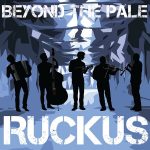At first listen for a non-aficionado, Beyond the Pale’s Ruckus may sound like a klezmer CD. An excellently executed and enjoyable one, with maybe a little more swing than you’ve heard before, but klezmer – Southeastern European Jewish music, the accordion, violin and clarinet prominent. On second play, however, is that a reggae beat? Did that piece sound like a French folk song in parts? Is that a mandolin?
Beyond the Pale is known for their fusion of klezmer with jazz, bluegrass, reggae and even classical music. Ruckus is the Toronto-based group’s fourth CD. They debuted with Routes in 2001. Their live recording, Consensus (2004), won three awards and Postcards (2009) also won a bunch of awards. While too early to predict, as Ruckus was just released in June, it would not be surprising if more awards were on the way.
Ruckus isn’t a wedding dance soundtrack. Though it has upbeat pieces that make you want to whirl around your kitchen as you cook dinner – “Ispravnost Licne Vizue” and “Batuta,” for example – it evokes a range of emotions. “Moldavsky” has a stately feel, like one of those ballroom waltzes Jane Austen writes about, while “Ruckus in Ralia” has a driving beat and a sense of urgency. “Andale” slows things down and has a contemplative feel, while listening to “Shutka” will take your imagination to the patio of a Parisian café, with its mournful clarinet and accordion, delicately plucked and wavering mandolin strings, and rich violin tones – a tune resembling “My Funny Valentine” seems to make its way into this eclectic composition.
“Oltenilor” sounds like it’d be at home at a hoedown and “Batuta” has a swinging jazz feel to it for the most part, but sounds like a Chassidic niggun at times and morphs into a kind of fast-paced square dance. Both of these songs feature some wicked plucking of the mandolin.
In Eric Stein’s hands, it’s hard to believe that the mandolin is not a traditional klezmer instrument. His original contribution composition-wise on Ruckus is “The Whole Thing,” the idea for which, he told the CJN, he came up with while playing with whole-tone scales. “It’s got tonality that reflects klezmer and Eastern European folk influences, but it’s also got a funky kind of groove.” And it is definitely based on whole-tone scales.
Six of the 12 songs on Ruckus are originals, while the others are arrangements of traditional melodies. All of the musicians – Bret Higgins (bass), Milos Popovic (accordion), Martin van de Ven (clarinet) and Aleksandar Gajic (violin) – either composed an original piece or participated in the arranging. They are a tight ensemble who play around with tempo and style with such ease that the complexity of what they’ve created isn’t what you’ll first notice. And that’s what makes their music so good.


